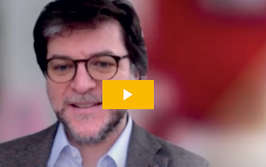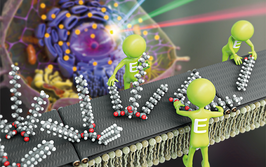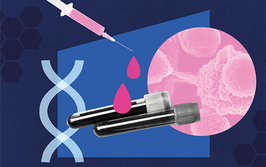Superior Separations
Burcu Gumuscu explains an exciting method of DNA fractionation
What inspired you to develop a new DNA separation technique?
The idea of introducing a new separation mechanism (1) to the mature field of gel electrophoresis excited me. During the research process, I focused on the design, functionality, and originality of the concept. Functional requirements have become the most prominent aspect for me, because things like economic value and societal embedding come into play when products are ready for commercialization. This technology has great potential to be commercialized, because it offers better functionality than existing technologies. For example, it can help diagnose genetic disorders using a much smaller sample than current devices.From the beginning, my project was about using the “continuous flow separation” method of fractionating DNA – so I focused on developing 2D separation matrices.
What are the challenges in separating DNA?
Standard gel electrophoresis is simple, versatile, and reproducible; however, it suffers from long processing times (many hours or even days). Trends toward next generation sequencing motivate the replacement of standard gel electrophoresis with microchip-based systems, which could provide efficient platforms to minimize the processing time and optimize DNA fractionation. To increase sample throughput and facilitate sample recovery, I feel that continuous flow separation is the way forward.
An ideal sieving matrix should have simple design and fabrication steps, yet provide high-resolution, high-throughput separation. That’s why I opted for gel-based devices. People had originally considered continuous flow separation in such devices impossible, but I showed that it could work.
Could you share more details about the chip?
The new chip can separate DNA fragments within minutes, in high resolution, and even purifies the fragments by removing contaminant salts.
In the classic DNA electrophoresis approach, an electric field is applied in one direction in a gel matrix and DNA fragments with different base pair numbers are separated in that direction. Performing continuous injection and separation at the same time in a single device can reduce the overall experimental time. In our microchip, different DNA fragments follow different trajectories in the gel; smaller fragments move faster than large ones in the low field (separating them), whereas both move equally fast in the high field (resulting in rapid transport through the chip).
The device itself is made of glass and has a 1 cm² agarose-filled separation chamber with microchannels on the sides to properly direct the electric fields (see Figure 1). Next to that are a DNA reservoir and electrodes for applying the fields (see Figure 2). The chip is cheap and relatively easy to produce – and it is versatile as well; the type and concentration of gel and the electric fields can be adjusted to the application.

Figure 1.

Figure 2.
What can the device offer in the clinic?
The microchip would be of broad interest for next generation sequencing and clinical diagnostics, as it requires less effort and expense than current devices to produce similar performance and much faster separation times. For instance, the detection of pathogenic diseases by sorting pathogenic nucleic acids is of great interest in the clinic, as is the identification and analysis of biomolecules to diagnose genetic diseases. Our device can help by reducing the amount of sample needed to obtain results, and by speeding up the time to results; it can also be integrated into a more complex analysis system. In fact, its applications can even be extended to protein gel electrophoresis, simply by replacing the agarose gel with a polyacrylamide gel.
- B Gumuscu et al., “Exploiting biased reptation for continuous flow preparative DNA fractionation in a versatile microfluidic platform”, Microsystems & Nanoengineering, 3, 17001 (2017).

While obtaining degrees in biology from the University of Alberta and biochemistry from Penn State College of Medicine, I worked as a freelance science and medical writer. I was able to hone my skills in research, presentation and scientific writing by assembling grants and journal articles, speaking at international conferences, and consulting on topics ranging from medical education to comic book science. As much as I’ve enjoyed designing new bacteria and plausible superheroes, though, I’m more pleased than ever to be at Texere, using my writing and editing skills to create great content for a professional audience.




















